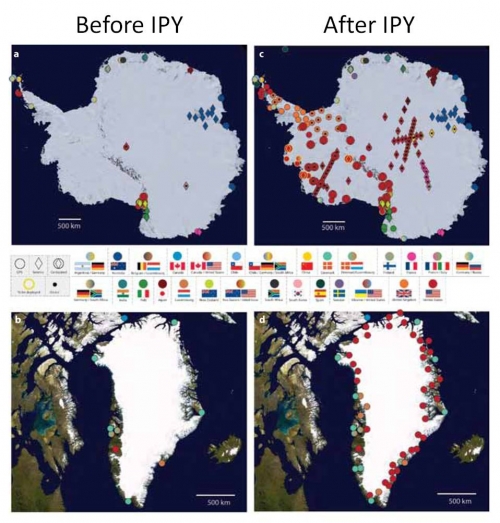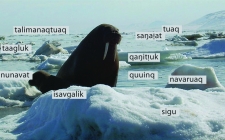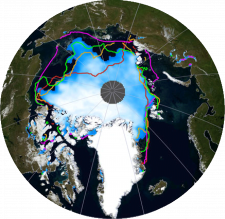In April 2012, the Polar Research Board (PRB) of the U.S. National Academy of Sciences released a report on the Lessons and Legacies of International Polar Year 2007-2008. It reports that the International Polar Year (IPY) was an intense, coordinated field campaign of observations, research, and analysis that led to numerous scientific advances and discoveries. IPY engaged the public to communicate the relevance of polar research to the entire planet, strengthened connections with the Indigenous people of the Arctic, and established new observational networks. The report explains how activities at both poles led to scientific discoveries that provided a step change in scientific understanding and helped translate scientific knowledge into policy-relevant information. At a time when the polar regions are undergoing a transformation from an icy wilderness to a new zone for human affairs, these insights are both timely and relevant.
The report is structured to reflect the important facets of IPY: the human element, scientific advances and discoveries, scientific tools and infrastructure, knowledge to action, and reflections.
The Human Element
People were the engine that powered IPY. Notably, IPY projects encouraged international collaboration that allowed the polar science community to become more connected and that leveraged infrastructure and intellectual assets from multiple nations to make numerous research projects more efficient. A major objective of IPY was to create new connections between science and the public to increase understanding of the role of the poles in global systems through a broad spectrum of education and outreach activities. One example is Polar Palooza, which engaged audiences with big-screen video presentations, music, and opportunities to interact face-to-face with dynamic polar researchers and arctic residents with powerful stories to tell.
Scientific Advances and Discoveries
IPY helped develop new collaborations that enhanced scientists' observational capacity in many of the poles' most remote areas. For example, the Gamburtsev mountain range under the Antarctic ice sheet was discovered during the International Geophysical Year in 1957-58, but its extreme inaccessibility meant that it remained uninvestigated until this IPY. Seven countries collaborated on the Antarctic Gamburtsev Province (AGAP) project, which used cutting-edge airborne radar to investigate the subglacial mountains that are thought to be the initial originating site of the East Antarctic ice sheet millions of years ago.
Scientific Tools and Infrastructure
IPY saw not only the use of existing tools in new places, but also the deployment of new tools that will remain in place long after IPY. A number of observing networks established during IPY combined or extended data collection capabilities beyond what single countries or projects could install or sustain. The Polar Earth Observing Network (POLENET) is an example of a land-based observational network for geodesy and seismology established at both poles during IPY. Data from these stations will contribute important insights into internal processes of ice and rates of ice loss at both poles.

Knowledge to Action
IPY activities, particularly in human health, community vulnerability, and local observations of change, sought to convert scientific data into societally relevant information to be shared with polar communities, local agencies, and grassroots organizations in the Arctic. One example comes from the IPY Sea Ice for Walrus Outlook (SIWO), a web-based monitoring and data-sharing network in the Bering Strait region. Developed by ice scientists in partnership with the Eskimo Walrus Commission and several local village monitors, SIWO uses high resolution satellite images, analysis of weather and ice patterns, and observations from local scientists and Indigenous experts to provide forecasts for the spring ice breakup relevant to walrus migration in the northern Bering Sea region.
Reflections
Coming at a time of rapid polar and global change, IPY investments enabled the scientific community to observe and benchmark the state of the polar system. The inclusiveness of IPY helped ensure that the polar research community grew in number, skill, and knowledge, and researchers have forged new collaborations to carry out ambitious projects far beyond the capability of any single nation. Although not everything worked perfectly during IPY, evidence shows that IPY was an overwhelming success.
Investigating Arctic Sea Ice


With a 2007 minimum sea ice extent 27 percent lower than the previous record low in 2005, IPY provided an unprecedented opportunity to study the Arctic in a time of rapid change. Several projects investigated sea ice thickness and the mechanisms behind melting. In this satellite image (left), the red line marks the September 2007 sea ice extent, the orange line the extent for September 2008, the green line the September 2009 extent, and the pink line the climatological monthly mean for September 1979-2000. To broaden perspectives and gain more historical information on sea ice, IPY projects matched Indigenous knowledge of sea ice with scientific data. For example, Indigenous terms (right) can distinguish between numerous types of ice and related phenomena in a small area, easily describing the various ice formations shown in the image on the right, such as large floes (puktaat), vertical blocks of ice (puikaanit), pieces of dirt ice (taaglut), and small floating pieces of ice (sangalait).
From outreach activities that engaged the general public to projects that brought researchers from multiple disciplines and several nations together, the legacies of IPY extend far beyond the scientific results achieved, and valuable lessons learned from the process will guide future endeavors of similar magnitude. The world will continue to change, and processes of polar amplification will continue the rapid transformation of the high latitudes in coming decades. The legacy of IPY will help society to understand these changes and put knowledge into action, forging new frontiers in the understanding and management of the planet's resources at all latitudes.
The Lessons and Legacies of International Polar Year 2007-2008 report is available as a free PDF download: at http://www.nap.edu/catalog.php?record_id=13321 and paper copies are available for purchase through the National Academies Press at 888-624-8373.
The PRB is a unit within the National Academies and is responsible for studies related to the Arctic and Antarctic, and cold regions in general. For more information about the PRB and to sign up for the e-newsletter, please visit their website: http://dels.nas.edu/prb/.
